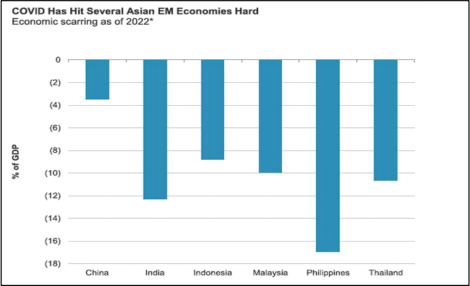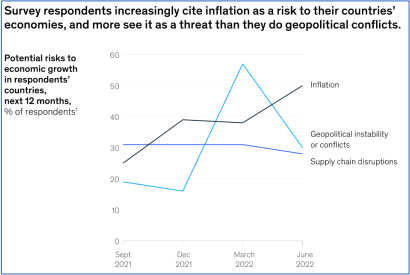CT071-3-3-DDAC - DESIGNING & DEVELOPING CLOUD APPLICATIONS
Hello, dear friend, you can consult us at any time if you have any questions, add WeChat: daixieit
CT071-3-3-DDAC - DESIGNING & DEVELOPING CLOUD APPLICATIONS
GROUP PROJECT
Lecturer(s) :
Date Assigned : Week 7
Date Due : Week 14
LEARNING OUTCOMES
At the end of this project, you should be able to:
CLO1 Explain the core concepts of the cloud computing paradigm and its future challenges. (C2,PLO1) Class Tests
CLO2 Design an application using recommended performance criteria that is suitable for deployment in a cloud platform. (C6, PLO2) Presentation
CLO3 Combine all the related cloud services to build a high-availability application. (A4, PLO6) Group Project
BACKGROUND
Just one quarter after geopolitical conflicts and instability overtook the COVID- 19 pandemic as the leading risk to economic growth, survey respondents’ concerns over inflation now exceed their worries about the effects of geopolitical issues on their countries’ economies (McKinsey & Company, 2022).

Figure 1 Economic Scarring vs GDP (Sunbiz, 2022)
Malaysia is expected to have one of the largest scarrings among Asian emerging markets post-Covid pandemic, according to S&P Global Ratings. In its Economic Outlook Asia-Pacific Q3 2022, S&P projected Malaysia’s scarring to be 10% of gross domestic product (GDP), after the Philippines, India and Thailand. Malaysia is expected to have one of the largest scarrings among Asian emerging markets post-Covid pandemic, according to S&P Global Ratings. In its Economic Outlook Asia- Pacific Q3 2022, S&P projected Malaysia’s scarring to be 10% of gross domestic product (GDP), after the Philippines, India and Thailand. Economic scarring refers to the difference between S&P’s forecast and the level of GDP if growth had been at potential since 2019 (Sunbiz, 2022).
S&P expects Malaysia’s real GDP growth to come in at 6.1% for 2022 and lower at 5.0% for 2023. Generally, it said Asia-Pacific (excluding China) economic growth eased in early 2022 after the rebound in 2021. The slowdown was most pronounced in Hong Kong and least visible in Malaysia. “Government policy has impacted inflation in the country. While energy price inflation generally remains high, that is not so in Malaysia and Indonesia. The two economies are net energy exporters and are not passing on some of the energy commodity cost increases to consumers,” S&P said. Malaysia’s inflation, which was 2.5% in 2021, is estimated to inch up to 2.9% for 2022, 2.2% for 2023, and 2.3% for 2024 and 2025. The rise in inflation has led central banks in Australia, India, Malaysia, and the Philippines to join others in starting to normalise monetary policy. Still, consumer inflation has generally not risen as much as in the US and Europe. Core CPI pressures have only started picking up recently since the post-Covid recovery in domestic demand has been more muted. It expects the ringgit to hover at 4.32 against the US dollar this year, 4.22 for 2023, 4.12 for 2024 and 4.04 for 2025 (Sunbiz, 2022).

Figure 2 Survey on economic conditions (McKinsey & Company, 2022)
However, in the latest McKinsey Global Survey on economic conditions, respondents most often cite inflation as a risk over the next year (Figure 2). They are now nearly half as likely as they were in the previous survey to cite geopolitical issues as a risk to their countries’ economies. However, geopolitical conflicts and instability remain an outsize concern in Europe, where 50 percent list it among their top risks. But even in Europe, inflation is the risk cited most often—as it is in every geography except Greater China. There, respondents most often point to the COVID- 19 pandemic (McKinsey & Company, 2022).
QUESTION:
Given the current economic situation in Malaysia, you and your friends intend to help some small businessmen in rural area or small town to develop an interactive web application that can help these small traditional businesses go digital and boost the growth of the Malaysian business economy.
You can develop this web application in any web development language. However, application architecture must apply distributed and cloud-based design philosophies. You must integrate various cloud services, cloud storage options to optimize performance and availability.
After completion, the web application must be deployed to the AWS cloud environment and use their monitoring tools to analyse your application performance.
Before your team can start designing and developing a website application, your team must first conduct some online research and find a suitable project scope, including their business problem statement, business goals, and more. However, you can only specialize in the following 8 industries:
1. Fisheries and marine industry
2. Agribusiness industry
3. Confectionery and chocolate industry
4. Pastry and cake Industry
5. Automotive service and hardware industry
6. Furniture manufacturing industry
7. Traditional handicraft (e.g., bamboo / batik products) industry
8. Baby products industry
![]()
Rules of Project
![]()
• A minimum of 2 students and a maximum of 3 students can form a group.
• The exact topic must be agreed upon with the lecturer before your team start.
• However, the actual content of the website is entirely up to your team and must be within the context of this module.
• This group project requires you and your team to share the workload equally. Each member should focus on at least one cloud service within the system.
• Marks are awarded depending on the individual contribution to each section of the project including system, documentation, and presentation,
• Each industry maybe chosen by up to 7 groups of students.
• This group project will be divided into 2 different submission phases, which is:
1. Proposal Phase in Week 9
2. Final System and Documentation Phase in Week 14
IMPLEMENTATION SECTION (CLO3 - 30 Marks):
Below are the minimum requirements for the web application.
1. Design, develop and host web-based applications on the Amazon Web Services (AWS) cloud as an application hosting cloud infrastructure.
2. The minimum TWO (2) user roles must be included in the system.
3. This project must include the Amazon RDS service as part of the system.
4. In addition,
• A group of two student - at least TWO (2) of the following AWS cloud services
• A group of three student - at least THREE (3) of the following AWS cloud services
should also be utilized in your system architecture. You must briefly explain why you select them and how you use them.
• AWS S3 Storage • AWS Lambda
• AWS Dynamo DB Database • AWS API Gateway
• AWS Simple Queue Service • AWS CloudFront
• AWS Simple Notification Service • AWS Step Functions
5. Your cloud application must consist of at least 12 interlinked pages. You are required to provide a quality content and design for your system. Your application should include the user login and logout pages.
6. To be able to scale the solution to meet the needs of demands during peak sessions.
7. During the deployment stage, use the AWS CloudWatch and X-Ray services to analyse your cloud application performance. Must include the Latency Testing for your web site.
DOCUMENTATION SECTION (CLO3 - 30 Marks)
Proposal Submission Stage (Week 9) - 8 Marks
• Submission Date: Week 9
• Submission format: PowerPoint
• Approximation of Total Slides: 20 - 30 (max)
• The PowerPoint should include the following contents:
1. Cover Page with Team Member Details
2. Table of Contents
3. Workload Distribution Table
4. Project Background includes problem statements and objectives
5. Project Plan
6. Design
- Propose Solution: Cloud Architectural Style and Diagram for the project
- Use Case Diagram & Flowcharts
- Cloud Services that used in the project
7. Project Summary
Final Documentation Submission Stage (Week 14) - 22 Marks
• Submission Date: Week 14
• Submission format: Word Documentation
• Approximation of Total Pages: 30 - 40 (max)
• The documentation should include the following contents:
1. Cover Page with Team Member Details
2. Table of Contents
3. Introduction
4. Implementation
- Cloud Services Deployment Screenshot and discussions.
- Code Snippets for each function related to cloud services.
- User Manual
5. Test Plan
- Unit & Integration Testing
- Performance Testing
6. System Limitation
7. Conclusion and Reflections
8. Bibliography
9. Appendix
PRESENTATION SECTION (CLO2 - 40 Marks):
- Implementation section will be assessed by a 30 - 40 minutes demonstration.
- Q&A section inclusive:
i. Topics regarding to current cloud computing
ii. Application development and deployment section
iii. Analysis on the application performance
SUBMISSION
. The completed solution MUST be published in Amazon Web Services Cloud. You should also provide the website URL in the documentation.
. Project Documentation (softcopy) & source code & SQL database contents need to submit to the MOODLE account that prepared by the lecturer.
PERFORMANCE CRITERIA
• Please refer to the Marking Scheme.
PLAGIARISM
Verbatim reproduction of material from external sources (webpages, books, papers, etc.) is not acceptable. If you are paraphrasing external content (or even your own prior work) or were otherwise influenced by them while completing your assignments, projects or exams, you must clearly acknowledge them. When in doubt, add a citation.
Grading:
|
Grade |
|
Range |
|
A+ |
Distinction |
>=80% |
|
A |
75-79% |
|
|
B+ |
Credit |
70-74% |
|
B |
65-69% |
|
|
C+ |
Pass |
60-64% |
|
C |
55-59% |
|
|
C- |
50-54% |
|
|
D |
Marginal Fail |
40-49% |
|
F+ |
Fail |
30-39% |
|
F |
20-29% |
|
|
F |
0- 19% |
|
Marking Band |
Band Description |
|
|
|
80- 100 % |
Exceptional problem solving with supporting analysis and application development skills with extraordinary originality and adoption of new tools, platforms, methods & technologies. Work maybe considered for further expansion. |
|
75-79 % |
Outstanding problem solving and application development skills. |
|
|
70-74 % |
Excellent knowledge base that supports analysis, evaluation, problem-solving and application development of discipline with considerable originality |
|
|
65-69 % |
Good knowledge base that supports analysis, evaluation, problem-solving and application development. |
|
|
60-64 % |
Satisfactory knowledge base that supports some analysis, evaluation and problem- solving and application development. |
|
|
55-59 % |
Basic knowledge base with some omissions at the level of technology. Restricted ability to discuss and/or or solve problems. |
|
|
50-54 % |
Limited knowledge base. Limited understanding of discipline. Difficulty with problem solving and application development. |
|
|
40-49 % |
Little evidence of knowledge base. Little evidence of understanding of discipline. Significant difficulty with problem solving and application development. |
|
|
30-39 % |
Inadequate knowledge base. Inadequate understanding of discipline. Major difficulty with problem solving and application development. |
|
|
20-29 % |
No evidence of knowledge base; no evidence of understanding of discipline. Total inability of problem solving and application development. |
|
|
0- 19 % |
Awarded for: (i) non-submission; (ii) dishonesty; (iii) in situations where the student fails to address the project brief (e.g.: answers the wrong question) and/or related learning outcomes |
|
Bibliography
McKinsey & Company. (June, 2022). The coronavirus effect on global economic sentiment. Retrieved from https://www.mckinsey.com/capabilities/strategy-and-corporate-finance/our- insights/the-coronavirus-effect-on-global-economic-sentiment
Sunbiz. (June, 2022). Covid-19 pandemic leaves scar on Malaysia economy. Retrieved from https://www.thesundaily.my/home/covid- 19-pandemic-leaves-scar-on-malaysian-economy- BL9386012
2024-01-10